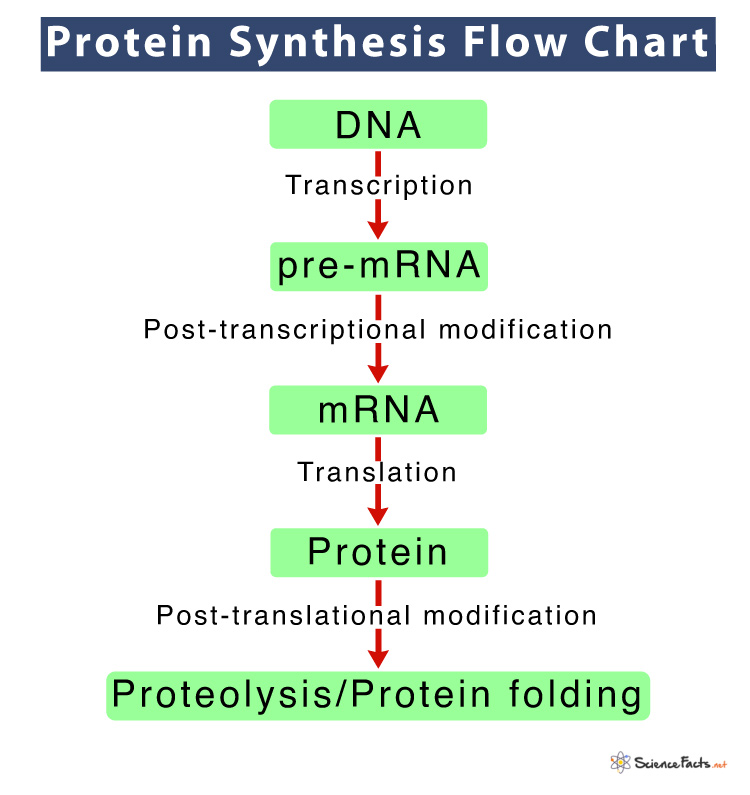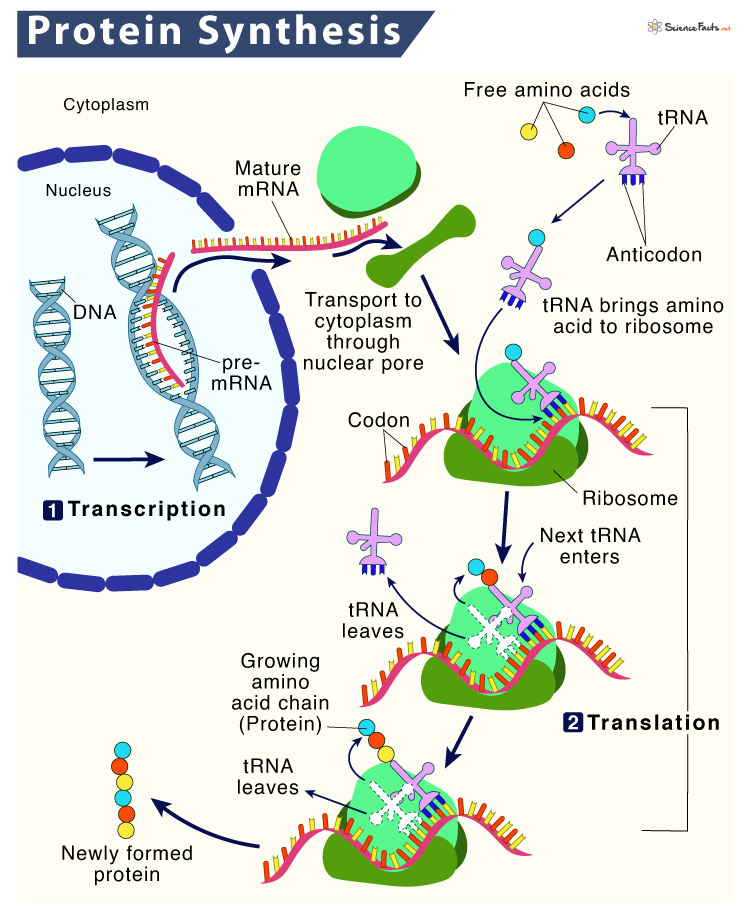Protein Synthesis
Protein synthesis, as the name implies, is the process by which every cell produces specific proteins in its ribosome. In this process, polypeptide chains are formed from varying amounts of 20 different amino acids. It is one of the fundamental biological processes in both prokaryotes and eukaryotes. This is a vital process, as the proteins formed take part in every major cellular activities, ranging from catalysis to forming various structural elements of the cell.
In 1958, Francis Crick proposed a theory called central dogma to describe the flow of genetic information from DNA to RNA to protein. According to this framework, protein is formed from RNA via translation, which in turn, is formed from DNA through transcription.
DNA → RNA → Protein
i. DNA → RNA (Transcription)
ii. RNA → Protein (Translation)
Where and When does Protein Synthesis Take Place
In both prokaryotes and eukaryotes, protein synthesis occurs in the ribosome. That’s why the ribosome is called the ‘protein factory’ of the cell.
However, in eukaryotes, the ribosomes remain scattered in the cytoplasm and are also attached to the Endoplasmic reticulum (RER). So, generally, it is said that, in eukaryotes, the process occurs in the cytoplasm and RER.
On the other hand, in prokaryotes, the ribosomes are scattered throughout the cell cytoplasm. So, commonly, it is said that, in prokaryotes, it takes place in the cytoplasm.
Process: How does it Work
The process of protein synthesis occurs in two steps: transcription and translation. In the first step, DNA is used as a template to make a messenger RNA molecule (mRNA). The mRNA thus formed, exits the nucleus through a nuclear pore and travels to the ribosome for the next step, translation. Upon reaching the ribosome, the genetic code in mRNA is read and used for polypeptide synthesis.
Below is a flowchart of the overall process:
Now, let us discuss these two steps of protein synthesis in detail:
1) Transcription: The First Step of Protein Synthesis
In this process, a single-stranded mRNA molecule is transcribed from a double-stranded DNA molecule. The mRNA thus formed is used as a template for the next step, translation.
The three steps of transcription are: initiation, elongation, and termination.
i) Initiation
The process of transcription begins when the enzyme RNA polymerase binds to a region of a gene called the promoter sequence with the assistance of certain transcription factors. Due to this binding, the double-stranded DNA starts to unwind at the promoter region, forming a transcription bubble. Among the two strands of DNA, one that is used as a template to produce mRNA is called the template, noncoding, or antisense strand. On the other hand, the other one is called the coding or sense strand.
ii) Elongation
After the opening of DNA, the attached RNA polymerase moves along the template strand of the DNA, creating complementary base pairing of that strand to form mRNA. As a result of this, an mRNA transcript containing a copy of the coding strand of DNA is formed. The only exception is, in the mRNA, the nitrogenous base thymine gets replaced by uracil. The sugar-phosphate backbone forms through RNA polymerase.
iii) Termination
Once the mRNA strand is complete, the hydrogen bonds between the RNA-DNA helix break. As a result, the mRNA detaches from the DNA and undergoes further processing.
Post Transcriptional Modification: mRNA Processing
The mRNA formed at the end of the transcription process is called pre-mRNA, as it is not fully ready prepared to enter translation. So, before leaving the nucleus, it needs to undergo some modifications or processing to transform into a mature mRNA. Following these modifications a single gene can produce more than one protein.
a. Splicing
The pre-mRNA is comprised of introns and exons. Introns are the regions that do not code for the protein, whereas exons are the regions that code for the protein.In splicing, noncoding regions or introns of the mRNA get removed under the influence of ribonucleoproteins.
b. Editing
Here, the mRNA gets edited, that is, its some of the nucleotides get changed. For instance, a human protein called Apolipoprotein B (APOB), which helps in lipid transportation in the blood, comes in two different forms due to this editing. One form is smaller than the other because an earlier stop signal gets added in mRNA due to editing.
c. 5’ Capping
In this process, a methylated cap is added to the 5′ end or ‘head’ of the mRNA, replacing the triphosphate group. This cap helps with mRNA recognition by the ribosome during translation, and also protects the mRNA from breaking down.
d. Polyadenylation
At the opposite end of the RNA transcript, that is, to the 3′ end of the RNA chain 30-500 adenines are added, forming the poly A tail. It signals the end of mRNA, and is involved in exporting mRNA from the nucleus.
2) Translation: The Second Step of Protein Synthesis
Translation, the next major step of protein synthesis is the process in which the genetic code in mRNA is read to make the amino acids, which are linked together in a particular order based on the genetic code, forming protein.
Similar to transcription, translation also occurs in three stages: initiation, elongation, and termination.
i) Initiation
After the mature mRNA leaves the nucleus, it travels to a ribosome. The 5′ methylated cap of the mRNA, containing the strat codon binds to the small ribosomal subunit of the ribosome consisting rRNA. Next, a tRNA containing anticodons complementary to the start codon on the mRNA attaches to the ribosome. These mRNA, ribosome, and tRNA together form an initiation complex.The ribosome reads the sequence of codons in mRNA, and tRNA bring amino acids to the ribosome in the proper sequence.
ii) Elongation
Once the initiation complex is formed, the large ribosomal subunit of ribosome binds to this complex, releasing initiation factors (IFs). The large subunit of the ribosome has three sites for tRNA binding; A site, P site, and E site. The A (amino acid) site is the region, where the complementary anticodons of aminoacyl-tRNA (tRNA with amino acid) pairs up with the mRNA codon. This ensures that correct amino acid is added to the growing polypeptide chain at the P (polypeptide) site. Once this transfer is complete, the tRNA leaves the ribosome at the E (exit) site and returns to the cytoplasm to bind another amino acid. The whole process gets repeated continuously and the polypeptide chain gets elongated. The rRNA binds the newly formed amino acids via peptide bond, forming the polypeptide chains.
iii) Termination
The 3′ poly A tail of the mRNA holds a stop codon that signals to end the elongation stage. A specialized protein called release factor gets attached to the tail o mRNA, causing the entire initiation complex along with the polypeptide chain to break down. As a result, all the components are released.
What Happens Next
After translation, the newly formed polypeptide chain undergoes either of the two post-translational modifications discussed below:
- Proteolysis: Here, the proteins get cleaved, that is, their N-terminal, C-terminal, or the internal amino-acid residues are removed from the polypeptide by the action of proteases.
- Protein folding: In this stage, the nascent proteins get folded to achieve the secondary and tertiary structures.
After these modifications, the protein may bind with other polypeptides or with different types of molecules, such as lipids or carbohydrates, forming lipoproteins or glycoproteins, respectively. Many proteins travel to the Golgi apparatus where they are modified according to their role in cell.
Why is Protein Synthesis Important
As we can see, this complex process of protein synthesis leads to the formation of proteins that plays several crucial roles in cells, including formation of structural components of cell, like cell membrane, cell repair, producing hormones, enzymes, and many more.
Why is it Different in Prokaryotes and Eukaryotes
The speed of protein synthesis is different in prokaryotes and eukaryotes. In prokaryotes, the process is faster, as the whole process takes place in the cytoplasm. On the other hand, in eukaryotes it is slower, as the pre- mRNA is first synthesized in the nucleus and after splicing, the mature mRNA comes to the cytoplasm for translation.
FAQs
Ans. mRNA carries the coding sequences for protein synthesis from DNA to ribosome. tRNA decodes a specific codon of mRNA and transfers a specific amino acid to the ribosome.
Ans. Three types of RNAs are involved in protein synthesis: messenger RNA (mRNA), transfer RNA (tRNA), and ribosomal RNA (rRNA).
Ans. Deoxyribonucleic acid (DNA) provides the master code for protein synthesis.
Ans. The codon AUG, coding for methionine starts protein synthesis.
Ans. The two organelles that are involved in protein synthesis are: nucleus and ribosome.
Ans. Well defined reading frames are critical in protein synthesis, because without a well-defined reading frame, the peptide made from a given sequence could be completely different.
Ans. Yes, protein synthesis requires energy.
Ans. Protein synthesis is the process of producing a functional protein molecule based on the information in the genes. On the contrary, DNA replication produces a replica of an existing DNA molecule.
-
References
Article was last reviewed on Friday, February 17, 2023





